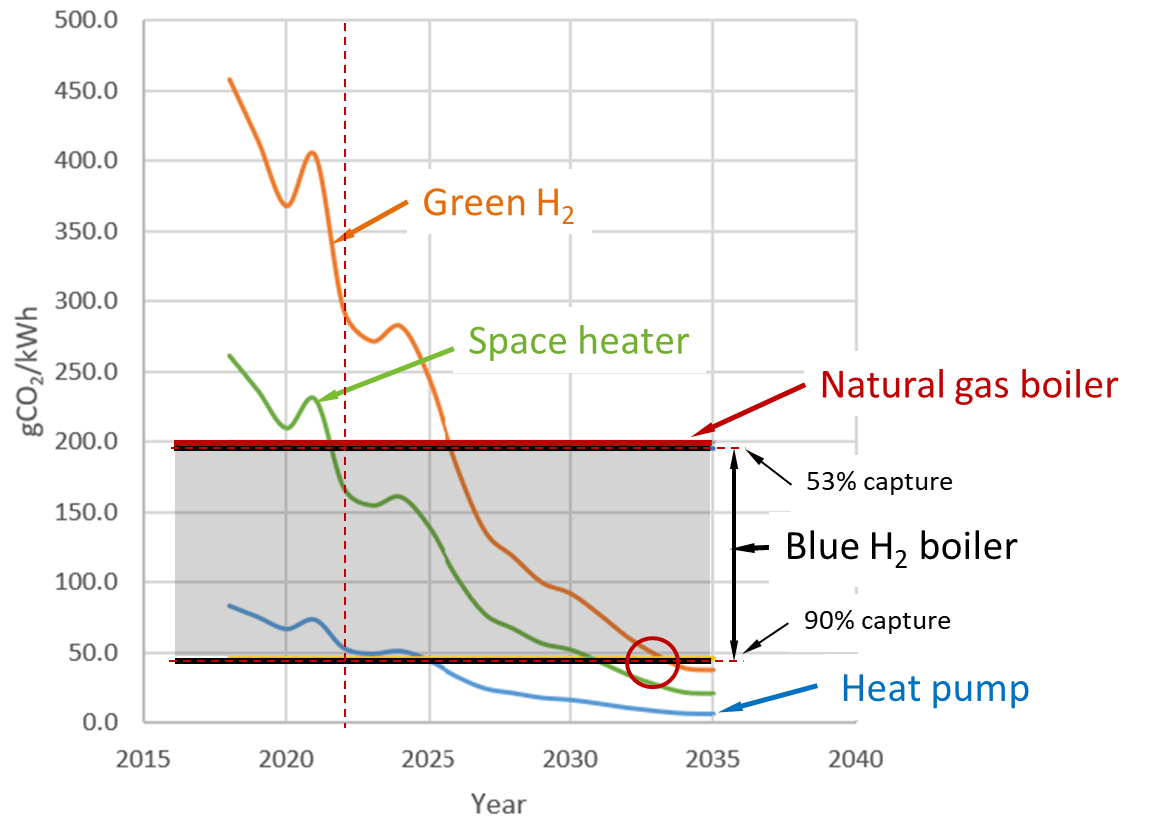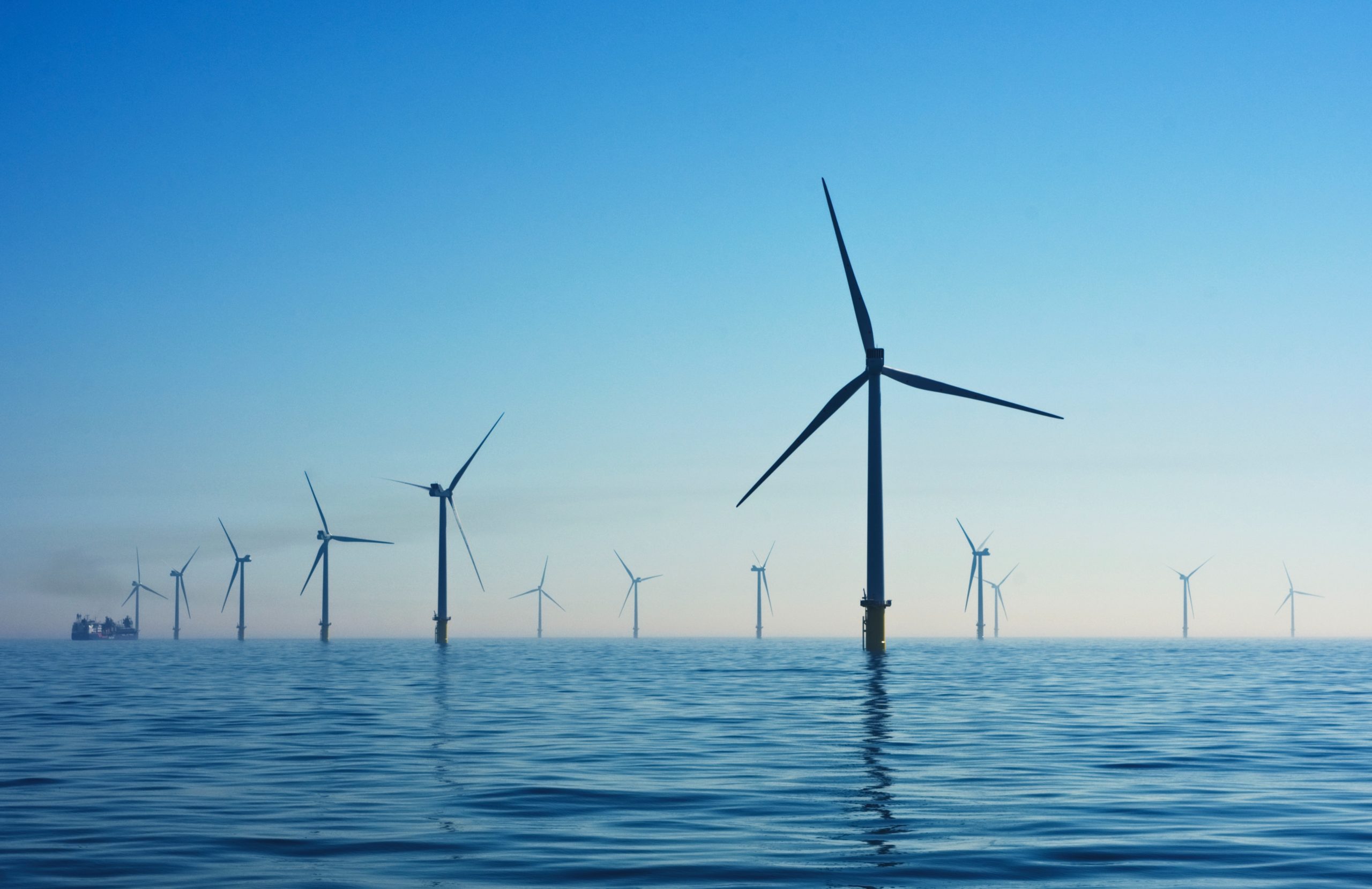Adapted from the ‘Hydrogen for heating?’ article by David Cebon – Director of the Centre for Sustainable Road Freight and the Cambridge Vehicle Dynamics Consortium; Professor of Mechanical Engineering, University of Cambridge.
In a low-carbon future, heating the UK’s buildings with hydrogen is often proposed as a pioneering alternative to the country’s gas-guzzling boilers.
The idea has gained political momentum in efforts to decarbonise domestic heating, alongside the more familiar option of heat pumps.
Here we examine what science indicates about the effectiveness of hydrogen-powered hot water boilers and electric-powered heat pumps, comparing both on the basis of energy efficiency and carbon emissions in this post, followed by technology readiness and infrastructure requirements in Part 2.
Energy efficiency
When it comes to energy efficiency, one solution vastly outperforms the other.
Heating buildings using green hydrogen involves using renewable electricity to produce hydrogen through electrolysis, which is then used to power hot water boilers.
This is 5.5 times less efficient than using the same electricity to directly power heat pumps.
This is because a large amount of energy is lost as waste heat from green hydrogen’s production to its final end use in buildings, including:
- during electrolysis to produce the hydrogen, which is about 75% efficient;
- in compressing and transmitting the hydrogen to end-use customers, which is particularly energy-intensive; and
- due to inefficiencies of the condensing boilers that burn the hydrogen to produce heat.
Ultimately, the overall process is less than 50% efficient [1].
Heating the UK
The UK’s housing stock had an average national requirement of about 70 GW of heat throughout the winter months of 2021 [2]. Accounting for the efficiency of hydrogen heating, 143 GW of renewable electricity would be needed to generate this heat [3].
To generate this electricity, 30,600 of the largest wind turbines equating to approximately 367 GW of installed offshore wind generating capacity would be required – covering a sea area larger than Denmark [4].

Figure 1: Providing domestic heating in the UK using either green hydrogen or heat pumps. The colours of the arrows indicate the type of energy: electricity, green hydrogen or heat. The widths of the arrows are proportional to the power flows (in units of GW). The blue boxes show scaled areas of wind turbine farms on the maps.
In comparison, meeting the same heating requirement using renewable electricity to directly power heat pumps would require a sea area less than a fifth of the size.
This is because the heat pump pathway, with the pumps using electricity to transfer heat from the outside environment into buildings, is approximately 270% efficient – compared to the green hydrogen pathway’s less than 50% efficiency.
This high efficiency is due to most of the heat being transferred rather than generated [5].
As a result, only 26 GW of renewable electricity is required to provide the same 70 GW of heat to consumers’ homes [6]. This requires an installed offshore wind capacity of approximately 67 GW in the form of 5,600 turbines, requiring a sea area of 9,000 km2 – less than a fifth of the size of Denmark.
What are the real-world implications of green hydrogen’s lower energy efficiency compared to heat pumps?
- 5.5 times more wind turbines, solar panels or nuclear power stations are needed to generate electricity;
- 5.5 times more capital is required to build this infrastructure;
- 5.5 times the price is paid by consumers to heat their homes, or the government subsidises the cost, causing a drain on the economy;
- 5.5 times more carbon emissions are produced, with environmental impacts from building and operating the electricity infrastructure.
Could using stored hydrogen provide a solution?
One solution that could halve renewable electricity generation for green hydrogen heating comes in the form of energy storage.
If the UK were to store all hydrogen generated during its six non-heating ‘summer’ months, from mid-spring to mid-autumn, it could later use this to supplement its winter-generated hydrogen – making it possible to generate green hydrogen all year round at half the rate.
This opportunity will be discussed in an article coming soon.
Carbon emissions
A commonly-held assumption is that using hydrogen for heating is a source of zero carbon emissions. This is not correct.
Hydrogen in its lowest-emission form is referred to as ‘green’, meaning it has been produced using renewable energy.
However, there will not be sufficient renewable electricity available in the UK to produce green hydrogen for decades, as explained above. This means it would be necessary to use grid-mix electricity to power hydrogen production for some time.
In light of this, future carbon emissions from heating the UK can be estimated based on the average emissions intensity of the country’s electricity grid – which is gradually becoming ‘cleaner’ as coal-fired power stations are phased out and renewable generation increases [7].

Figure 2: CO2 emissions from various heat sources.
Comparing the emissions of heating methods using UK grid electricity last year finds:
- A heat pump generated 53g of CO2e per kWh of heat delivered;
- An electric space heater generated 167g of CO2e per kWh of heat;
- A modern condensing natural gas boiler generated approximately 200g of CO2 per kWh of heat delivered, a level constant with time.
The highest-emission method at present is a green hydrogen-powered boiler, which would have generated 294g of CO2e per kWh of heat in 2022 – 5.5 times more than a heat pump.
Projections show that a green hydrogen-powered boiler will not start to deliver emissions lower than 2022’s heat pumps until 2033. By this time, heat pump emissions are expected to have dropped dramatically, reaching just less than 9g of CO2 per kWh of heat by 2033.
What about blue hydrogen?
Another form of hydrogen is referred to as ‘blue’, meaning it is produced from fossil fuels combined with carbon capture and storage (CCS).
However, powering boilers using blue hydrogen does not provide a lower-emissions solution.
The most effective CCS process results in 90% of carbon capture, but has an energy efficiency of just 69%. Processes with higher energy efficiencies tend to have lower capture rates, with this range shown as a shaded band in Figure 2.
The production of blue hydrogen furthermore generates fugitive methane emissions which would make it impossible to reach the net-zero carbon commitments of the UK government.
Conclusions
Heat pumps powered by electricity use less than one fifth of the electricity to deliver the same amount of heat as a boiler powered by green hydrogen.
Heat pumps can deliver immediate, deep cuts in carbon emissions – reducing emissions by 73% compared to existing natural gas boilers – while green hydrogen heating won’t reach the emissions performance of a natural gas boiler until 2026 or the performance of a 2022 heat pump until around 2033.
Footnotes:
[1] The overall efficiency of the process can be determined by multiplying the individual process efficiencies: 0.95×0.75×0.9×0.85×0.9 = 0.49, i.e. 49%.
[2] Based on a gas consumption of 318 TWh for domestic heating.
[3] 70/0.49 = 143 GW.
[4] 30,600 12MW wind turbines covering a sea area of approximately 49,600 km2.
[5] The efficiency of heat pumps is measured by a ‘Coefficient of Performance’ (COP) which is typically around 3: ie ‘300% efficiency’. Including 10% losses in electricity transmission, the overall efficiency of the process is approximately 270%.
[6] 70/2.7 = 26 GW.
[7] The average emissions intensity of the UK electricity grid in 2022 was 144g of CO2e for every kWh of electricity generated, according to the UK Treasury ‘Green Book’.
This article was updated on 11/10/2023.



